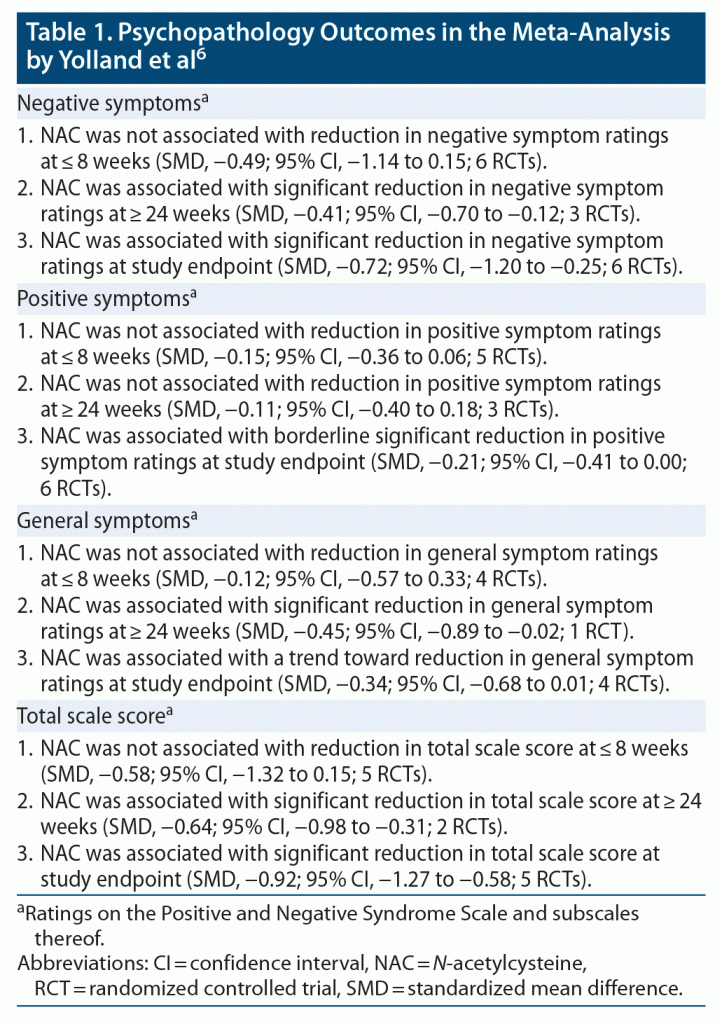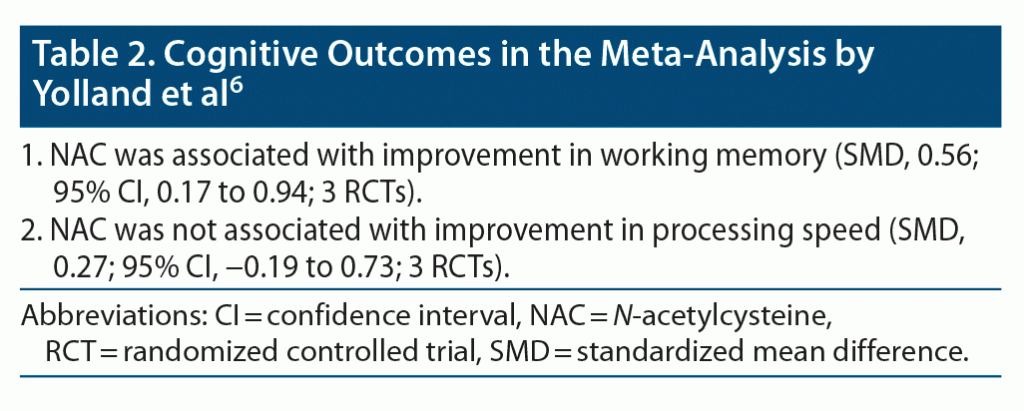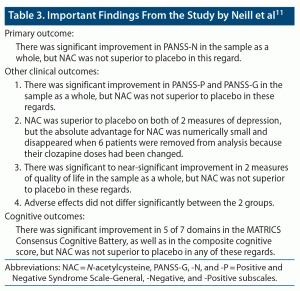ABSTRACT
N-acetylcysteine (NAC) augmentation of antipsychotic medication is one of very many antipsychotic augmentation strategies that have been studied in schizophrenia. A recent systematic review and meta-analysis of 6 randomized controlled trials (RCTs) found that NAC (median dose, 2,000 mg/d) improved several clinical outcomes at different time points with medium to large effect sizes; however, many of the significant findings in this meta-analysis are suspect because they appeared to be influenced by 2 short-term (8-week) RCTs with outlying characteristics. Important findings not influenced by the 2 outlying RCTs were significant attenuation by NAC of negative symptom (3 RCTs) and total psychopathology (2 RCTs) ratings at ≥ 24 weeks and improvement in working memory but not processing speed (3 RCTs). Of these findings, reduction in psychopathology ratings, though statistically significant, appeared too small to be clinically meaningful. Finally, a newly published, moderately large RCT of NAC (2,000 mg/d) in schizophrenia patients refractory to clozapine found that 1 year of treatment with NAC did not outperform placebo for any clinical, cognitive, or quality of life outcome. The take-home message is that it is premature to recommend the use of NAC to treat schizophrenia for any target domain in routine clinical practice and that there does not appear to be a role for NAC for any indication in clozapine-refractory schizophrenia. However, it may be worth studying whether NAC, dosed at 2,000 mg/d or higher for 6 months or longer, improves functional outcomes in schizophrenia.
J Clin Psychiatry 2022;83(5):22f14664
To cite: Andrade C. Antipsychotic augmentation with N-acetylcysteine for patients with schizophrenia. J Clin Psychiatry. 2022;83(5):22f14664.
To share: https://doi.org/10.4088/JCP.22f14664
© 2022 Physicians Postgraduate Press, Inc.
Treated patients with schizophrenia commonly do not recover completely from an episode of psychosis; some continue to experience positive symptoms, and many suffer residual negative symptoms as well as cognitive deficits. Very many treatment strategies have been trialed for patients who do not recover completely. These include changing the antipsychotic drug, dose, or formulation; augmenting with pharmacologic, psychosocial, or brain stimulation interventions; and using clozapine alone or with other treatments.
Pharmacologic augmentation strategies include augmenting with a second antipsychotic, an antidepressant drug, a mood stabilizer, a cholinesterase inhibitor, an anti-inflammatory drug, a glutamate (Glu) modulator, and others; the list is so long that it appears that almost every class of agents in the pharmacopoeia has been trialed.1 Nutraceutical augmentation has also been studied, such as with N-acetylcysteine (NAC).
Why NAC?
Abnormalities in dopamine (DA) and Glu signaling have long been associated with schizophrenia; NAC modulates both DA and Glu in the central nervous system. NAC is also a precursor of the endogenous antioxidant glutathione, levels of which are reduced in schizophrenia. Through these and other mechanisms, NAC has been suggested to improve mitochondrial functioning, dampen inflammatory mechanisms, exert neuroprotective action, and correct dysfunction in cortical circuits. The net effect could be therapeutic in schizophrenia, with dysregulated DA, Glu, and aspects of neuronal functioning as targets.2–4
Impressive laboratory results even from multiple fronts provide no assurance whatsoever of benefits in humans; clinical studies are necessary. In this context, NAC has been trialed in monotherapy and as augmentation therapy for several different neuropsychiatric indications, ranging from obsessive-compulsive disorder to tic disorders. An earlier article in this column examined possible benefits with NAC in major depressive disorder and bipolar depression.5 The present article examines its possible benefits in schizophrenia. A meta-analysis of randomized controlled trials (RCTs) is summarized, as is an important RCT that was published after the meta-analysis.
Meta-Analysis: NAC for Schizophrenia
Yolland et al6 described a systematic review and meta-analysis of RCTs comparing NAC with placebo as antipsychotic augmentation in patients with schizophrenia or early psychosis. These authors searched electronic databases, reference lists, conference abstracts, and other sources and identified 7 relevant publications from 6 studies. The studies had been conducted in Australia, China, Iran, Switzerland, and the US. Three studies were conducted in early schizophrenia and 2 in chronic schizophrenia; details were unavailable for the last study. Patients were receiving antipsychotic drugs in all studies. No study was enriched for treatment refractoriness or use of clozapine.
Study durations ranged from 8 to 52 weeks. Three RCTs were 8-week studies, 2 were 6-month studies, and 1 was a 1-year study. Study sample size ranged from n = 17 to n = 140; there were altogether 220 patients augmented with NAC and 220 with placebo. In these RCTs, NAC was dosed at 600 mg/d to 3,600 mg/d; the median dose was 2,000 mg/d. The risk of bias was rated as low in all but 1 study (from China, the study could not be located because it was wrongly referenced in the paper).
Important findings from the meta-analysis6 are presented in Table 1 and Table 2. In summary, NAC improved some outcomes at some time points, and some of the effect sizes were medium to large; the only clear findings, however, were that NAC outperformed placebo at ≥ 24 weeks for Positive and Negative Syndrome Scale-Negative (PANSS-N) and PANSS-Total outcomes, and that NAC improved working memory, but not processing speed, at study endpoint. The findings were consistent in sensitivity analyses in which the single RCT at high risk of bias was removed. Publication bias was not assessed because there were too few RCTs in the various analyses.
Critical Appraisal of the Meta-Analysis
One observation of concern is that whereas heterogeneity was low in most of the analyses, it was very high for the short-term (≤ 8 weeks) PANSS-N and PANSS-Total analyses (I2 = 89% and 90%, respectively) in both of which only the RCTs from Iran7 and China found a statistically significant advantage for NAC vs placebo. These RCTs were unusual in that in both, at baseline, patients were very severely ill; the mean PANSS total scores were about twice as high as those in the other RCTs (PANSS totals, 113–114 in these RCTs vs 56–64 in the other RCTs). Furthermore, in the Iranian RCT,7 at the 8-week study endpoint, NAC and placebo groups both improved remarkably: PANSS-Total dropped from 113.4 to 57.3 in the NAC group and from 114.6 to 70.2 in the placebo group; that is, by 50% vs 39%, respectively. Such a large improvement in 8 weeks with 2–6 mg of risperidone per day in a chronically ill cohort (illness duration > 2 years) is unexpected. Study findings could not be inspected for the Chinese RCT. On a final note, the Chinese RCT was the only study to be rated at high risk of bias; the study was red-flagged by Yolland et al6 for allocation concealment, patient blinding, rater blinding, and incomplete data.
Yolland et al6 did not state the weights assigned to the studies in the meta-analyses; so, readers don’t know the extent to which these 2 outlying RCTs drove the pooled estimates. Nevertheless, it is reasonable to assume that if these 2 RCTs were removed, the effect sizes for the early outcomes and the study endpoint outcomes (Table 1) would drop and perhaps even lose statistical significance.
The second observation of concern is that although all 6 RCTs used the PANSS to rate patients, Yolland et al6 reported pooled estimates not as mean difference but as standardized mean difference; so, readers do not get a sense of the absolute advantage for NAC over placebo. If we discount the analyses that might have been biased by the results of the Iranian and Chinese RCTs, we are left with the findings that NAC was superior to placebo for both PANSS-N and PANSS-Total outcomes at ≥ 24 weeks.
For the PANSS-N outcome, data were pooled from just 3 RCTs: those by Berk et al,8 Breier et al,9 and Conus et al.10 In these RCTs, at 24 weeks, the advantage for NAC over placebo for PANSS-N was approximately 1.8, 1.6, and 0.1 points, respectively; given that PANSS-N is scored between 7 and 49, it is very unlikely that such small values for advantage, though statistically significant, would be clinically evident and meaningful.
For the PANSS-Total outcome, data were pooled from just 2 RCTs: those by Berk et al8 and Breier et al.9 In these RCTs, at 24 weeks, the advantage for NAC over placebo for PANSS-Total was approximately 5.9 and 4.8 points, respectively; given that PANSS-Total is scored between 30 and 210, it is uncertain whether this statistically significant advantage would be clinically evident and meaningful.
RCT: NAC Augmentation of Clozapine
Neill et al11 described an investigator-initiated, industry-independent, moderately large (n = 84), well-designed, well-conducted, well-analyzed, 52-week RCT of NAC (2 g/d) in schizophrenia patients with persistent symptoms that were refractory to at least 3 classes of antipsychotic drugs as well as to ≥ 6 months of treatment with their current medication, clozapine. The study was conducted in medical centers in 4 cities in Australia.
The mean age of the sample was about 40 years. The sample was approximately 70% male. The mean duration of illness was about 18 years. The mean PANSS-Total score at baseline was about 69. Patients were assessed at baseline and, again, at 8, 24, and 52 weeks. The cumulated dropout rate was 15%, 29%, and 52% at these 3 follow-up points. There were 75 patients (88% of the original sample) in the intent-to-treat analyses. Medication adherence did not differ significantly between the 2 groups.
Important findings from this RCT are presented in Table 3. In short, NAC was not superior to placebo on any clinical or cognitive measure. It may seem that a floor effect12 was predestined because the authors studied clozapine-refractory patients, but then these are the very patients in whom unconventional interventions such as NAC need to be tested.
General Conclusions
Yolland et al6 concluded that, in patients with schizophrenia, NAC augmentation of antipsychotic medication may improve PANSS-N (3 RCTs) and PANSS-Total (2 RCTs) scores after 24 weeks of treatment. This conclusion is technically correct. However, readers must note that the conclusion is based on a small number of trials and that the absolute benefit may be too small to be clinically evident and meaningful. Importantly, the signal for improvement in PANSS-Total and in working memory (3 RCTs) should be evaluated in the context of functional outcomes, that is, changes in social, occupational, and other spheres of daily functioning, as well as changes in quality of life; so far, no such data are available. Whereas it is reasonable to further study clinical and functional outcomes with NAC dosed at 2,000 mg/d and higher for 24 weeks and longer, it is premature to recommend its use in routine clinical practice. Finally, there does not appear to be a role for NAC in clozapine-refractory schizophrenia.
Published online: September 26, 2022.
 Each month in his online column, Dr Andrade considers theoretical and practical ideas in clinical psychopharmacology with a view to update the knowledge and skills of medical practitioners who treat patients with psychiatric conditions.
Each month in his online column, Dr Andrade considers theoretical and practical ideas in clinical psychopharmacology with a view to update the knowledge and skills of medical practitioners who treat patients with psychiatric conditions.
Department of Clinical Psychopharmacology and Neurotoxicology, National Institute of Mental Health and Neurosciences, Bangalore, India ([email protected]).
References (12)

- Andrade C. The use of statins for antipsychotic augmentation in schizophrenia: examination of meta-analyses with flawed methods and conclusions. J Clin Psychiatry. 2018;79(5):18f12562. PubMed CrossRef
- Berk M, Malhi GS, Gray LJ, et al. The promise of N-acetylcysteine in neuropsychiatry. Trends Pharmacol Sci. 2013;34(3):167–177. PubMed CrossRef
- Minarini A, Ferrari S, Galletti M, et al. N-acetylcysteine in the treatment of psychiatric disorders: current status and future prospects. Expert Opin Drug Metab Toxicol. 2017;13(3):279–292. PubMed CrossRef
- McCutcheon RA, Krystal JH, Howes OD. Dopamine and glutamate in schizophrenia: biology, symptoms and treatment. World Psychiatry. 2020;19(1):15–33. PubMed CrossRef
- Andrade C. N-acetylcysteine augmentation for patients with major depressive disorder and bipolar depression. J Clin Psychiatry. 2021;82(1):21f13891. PubMed CrossRef
- Yolland CO, Hanratty D, Neill E, et al. Meta-analysis of randomised controlled trials with N-acetylcysteine in the treatment of schizophrenia. Aust N Z J Psychiatry. 2020;54(5):453–466. PubMed CrossRef
- Farokhnia M, Azarkolah A, Adinehfar F, et al. N-acetylcysteine as an adjunct to risperidone for treatment of negative symptoms in patients with chronic schizophrenia: a randomized, double-blind, placebo-controlled study. Clin Neuropharmacol. 2013;36(6):185–192. PubMed CrossRef
- Berk M, Copolov D, Dean O, et al. N-acetyl cysteine as a glutathione precursor for schizophrenia–a double-blind, randomized, placebo-controlled trial. Biol Psychiatry. 2008;64(5):361–368. PubMed CrossRef
- Breier A, Liffick E, Hummer TA, et al. Effects of 12-month, double-blind N-acetyl cysteine on symptoms, cognition and brain morphology in early phase schizophrenia spectrum disorders. Schizophr Res. 2018;199:395–402. PubMed CrossRef
- Conus P, Seidman LJ, Fournier M, et al. N-acetylcysteine in a double-blind randomized placebo-controlled trial: toward biomarker-guided treatment in early psychosis. Schizophr Bull. 2018;44(2):317–327. PubMed CrossRef
- Neill E, Rossell SL, Yolland C, et al. N-acetylcysteine (NAC) in schizophrenia resistant to clozapine: a double-blind, randomized, placebo-controlled trial targeting negative symptoms. Schizophr Bull. 2022;sbac065. PubMed CrossRef
- Andrade C. The ceiling effect, the floor effect, and the importance of active and placebo control arms in randomized controlled trials of an investigational drug. Indian J Psychol Med. 2021;43(4):360–361. PubMed CrossRef
This PDF is free for all visitors!






